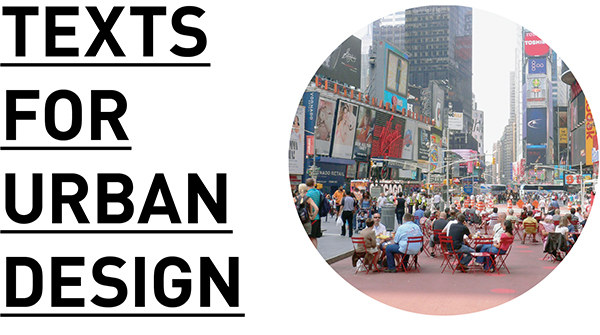PRINT PAGE
TEACHING
CASE STUDIES IN URBAN DESIGN: ELECTIVE COURSE HS17

Urban Design Theory: Texts, Positions, and Discourses
HS17: Places for People
The aim of this reading seminar is to gain deeper understanding of themes, positions and discourses within the field of urban design. The current class will introduce the environmentalist discourse regarding cities and will take a journey through different positions concerning the role of place in human life.
Urban Design is fundamentally about people. Questions about the role of place in human life are central to the discipline. There even exists a specific theory of urban form, place theory, that is based on the cultural and human characteristics of physical space, that is, on its psychological dimension. It is grounded in the thesis that physical space gains additional richness through unique details that are rooted in its genius loci and use. Place theory embraces the urban realm’s complexity by stating that place is created through the synthesis of different elements rather than by simple manipulation of spatial form. According to this approach, whereas space is a purposeful void with the potential of physically linking things, place is a space with distinct character and with contextual meaning that derives from cultural content. With other words, place theory puts emphasis on urban form‘s social-material relations, that is, on the reciprocal relationship between material space and human activities related to it.
Environmental behavior studies became prominent in the urban design discourse in the 1960s and 1970s with such classics making their appearance as Kevin lynch‘s Image of the City (1960), Jane Jacob‘s Death and Life of Great American Cities (1961) or Oscar Newman‘s Defensible Space (1972). After a shift in the discourse towards formalism, technological advancement and ecological sustainability, recently environmentalists once again have raised their voice promoting the centrality of human desires to spatial design. This can be exemplified with Jan Gehl‘s Cities for People (2010) or Christine Johnson Coffin‘s and Jenny Young‘s Making Places for People (2017).
Following an introductory lecture, we will discuss one text each week and juxtapose the different positions they represent to each other. Accordingly, participants will be expected to read one short text each week, to once prepare and hold a 15-minute presentation of a text and to actively participate in the discussions. Optionally, position papers can be written after the semester as elective theses. A reader with selected texts and short thematic introductions will be provided.
CLASSES: Thursdays, 4–6 pm
ROOM: HIL C 10.2
INTRODUCTION: Thursday, 21.9.2017, 4 pm
LANGUAGE: English
PARTICIPANTS: Max. 20
Mystudies: 052-0721-17
ECTS: 3 credit points
LECTURER: Daniel Kiss
